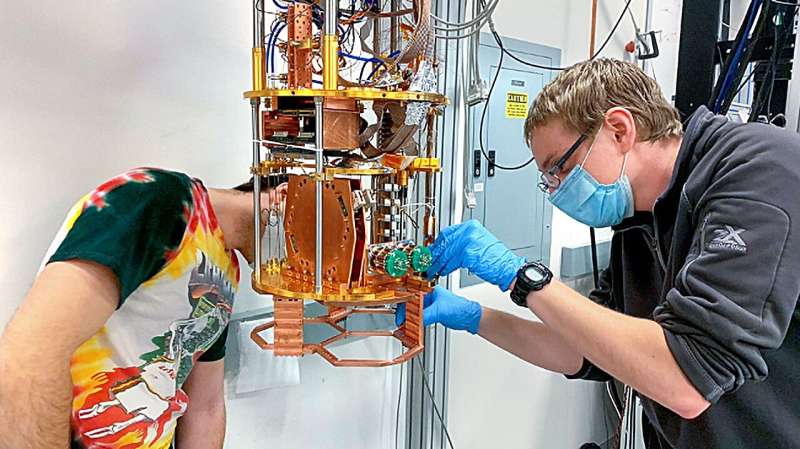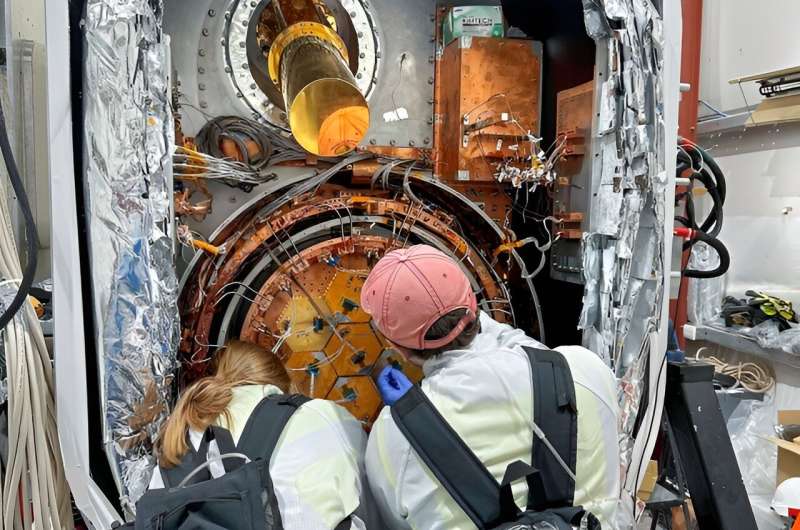This article has been reviewed according to Science X's editorial process and policies. Editors have highlighted the following attributes while ensuring the content's credibility:
fact-checked
trusted source
proofread
Simons Observatory begins measurements to probe Big Bang inflation

Almost 14 billion years ago, the universe was born in a blur of mystery. The new Simons Observatory in Chile's Atacama Desert may soon answer the great scientific question of what happened in that tiny fraction of a second after the Big Bang.
The Simons Observatory consists of a large aperture telescope and three smaller telescopes with about half a meter apertures—"very human-sized," said Michael Niemack, professor of physics and astronomy in the College of Arts and Sciences, who leads the Cornell team in the multi-institution collaboration. Two of the small aperture telescopes have completed their initial testing and the first scientific observations have begun, marking a major milestone in the decade-long project.
The large aperture telescope, when it comes online, will provide the best measurements of the Hubble constant and help explain why and how the universe is currently expanding, while the three small aperture telescopes will shed light on the initial inflation of the universe.
The large aperture telescope, said Niemack, is similar to the Fred Young Submillimeter Telescope (FYST) that he also works on, which Cornell and its partners are building in Chile, except that the Simons Observatory telescope is designed to work at longer wavelengths than FYST.
"The Simons Observatory telescopes can measure signals from the possible exponential expansion that we believe occurred a fraction of a second after the Big Bang," said Niemack. Those signals are fluctuations in the polarization of the cosmic microwave background (CMB) caused by gravitational waves generated in the instant after the Big Bang.
"These telescopes use some of the most advanced cosmic microwave background detector arrays ever built," he said.

The beginning of scientific observations has been an exciting moment for Niemack's team, which currently includes four undergraduate students, seven graduate students, three postdocs and a local high school volunteer. The team has spent years working on the detector array designs, as well as implementing and testing each of the subsystems of the telescope as part of the collaboration led by principal investigator Brian Keating of the University of California, San Diego.
"We have discoveries that we hope to make with these telescopes, but we don't know for sure what we will learn about the universe and its earliest galaxies and galaxy clusters as these new telescopes come online," said doctoral student Zachary Huber. "I'm excited to see these discoveries, whether they end up being the ones we expected or not."
There are seven detector arrays in each of the small aperture telescopes, arranged in a hexagonal shape with one in the middle surrounded by the other six. Each of these arrays has almost 2,000 detectors inside it.
"The detectors have to be cooled to very low temperatures—minus 273 degrees C, or about a 10th of a degree above absolute zero, to make them extremely sensitive to the tiny changes in intensity of the light from the early universe that we measure with our telescopes," Niemack said.
The detector array is very complex, Niemack said. Optical components actually gather the light; little antennas measure each of the two different linear polarizations of the light behind each of the optical components. Nano-fabricated structures transmit the light through circuits in the detector array and then convert that light into heat that can be measured using superconducting transition edge sensor devices that operate at the superconducting transition point, which enable them to be used as exquisitely sensitive thermometers.
Doctoral student Ben Keller, in addition to his work testing parts of the detector arrays for the telescope and characterizing the performance of the detectors, also got a particularly nerve-wracking job: he was one of the group who had to hand-carry the detector arrays from the U.S. to Chile.
"Since each array costs hundreds of thousands of dollars and is extremely fragile, carrying them through four airports was very daunting," Keller said. "Of course, for the installation of them on the telescope we had to be even more careful."
The Simons Observatory is located 17,000 feet up Cerro Toco in the Andes mountain range, which makes the work challenging and requires the use of oxygen supplementation.
"Working at that elevation was very exhausting," Keller said. "The air is thin and the sun is really intense. On my first day there I got sunburned through two layers of clothing."
Huber was in Chile last year with two of their Yale University collaborators installing several computers, networking devices, a massive storage drive and other computing infrastructure that will process and store data coming in from the telescopes.
"Part of the motivation for joining this particular trip was that we will eventually need to procure and install very similar equipment for FYST," said Huber, who has been working on doing that in the past year.
Even once all four Simons Observatory telescopes are actively doing science, the research and development for Niemack and his team on the instruments doesn't end. The Simons Observatory has already begun to build more detectors and more optics for the large aperture telescope, as well as solar panels to provide power to the observatory.
Provided by Cornell University





















